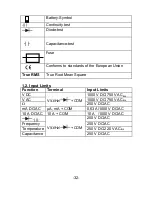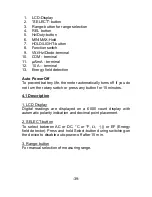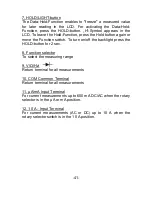
* Be sure that the circuit under test has all power removed
and that any associated capacitors are fully discharged
before you make a resistance measurement.
The resistance measuring circuit compares the voltage gained
through a known resistance (internal) with the voltage developed
across the unknown resistance. So, when you check in-circuit
resistance, be sure the circuit under test has all power removed
(all capacitors are fully discharged).
1. Set the rotary selector to the desired OHM range.
2.
Plug the black test lead into your meter’s COM terminal and
the red test lead into your meter’s V/
/Hz/- terminal.
3. Connect the test leads to the device you want to measure.
Notes:
* If the measured resistance value exceeds the maximum
value of the range selected, "OL" appears. This indicates an
overload. Select a higher range. In this mode, the beeper
does not sound.
* When you short the test leads in the 600
range, your
meter displays a small value (no more than 0.3
). This
value is due to your meter’s and test leads internal
resistance. Make a note of this value and subtract it from
small resistance measurements for better accuracy.
6.4. Checking diodes
This function lets you check diodes and other semiconductors
for opens and shorts. It also lets you determine the forward
voltage for diodes. You can use this function when you need to
match diodes.
1. Set the rotary selector to the
Ω/
/
°
))) position.
2. Press SELECT until occurs.
-46-






















